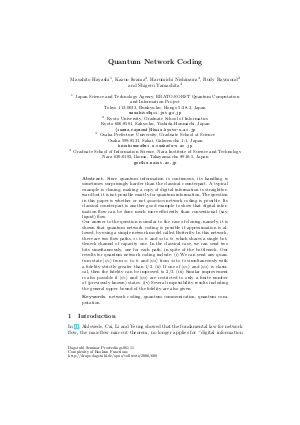Quantum Network Coding
Authors Masahito Hayashi, Kazuo Iwama, Harumichi Nishimura, Rudy Raymond, Shigeru Yamashita
-
Part of:
Volume:
Dagstuhl Seminar Proceedings, Volume 6111
Part of: Series: Dagstuhl Seminar Proceedings (DagSemProc) - License:
 Creative Commons Attribution 4.0 International license
Creative Commons Attribution 4.0 International license
- Publication Date: 2006-10-09
File

PDF
DagSemProc.06111.14.pdf
- Filesize: 387 kB
- 17 pages
Document Identifiers
Subject Classification
Keywords
- Network coding
- quantum computation
- quantum information
Metrics
- Access Statistics
-
Total Accesses (updated on a weekly basis)
0Document
0Metadata
Abstract
Since quantum information is continuous, its handling is sometimes
surprisingly harder than the classical counterpart. A typical
example is cloning; making a copy of digital information is
straightforward but it is not possible exactly for quantum
information. The question in this paper is whether or not {em
quantum} network coding is possible. Its classical counterpart is
another good example to show that digital information flow can be done
much more efficiently than conventional (say, liquid) flow.
Our answer to the question is similar to the case of cloning, namely,
it is shown that quantum network coding is possible if approximation
is allowed, by using a simple network model called Butterfly. In this
network, there are two flow paths, $s_1$ to $t_1$ and $s_2$ to $t_2$,
which shares a single bottleneck channel of capacity one. In the
classical case, we can send two bits simultaneously, one for each
path, in spite of the bottleneck. Our results for quantum network
coding include: (i) We can send any quantum state $|psi_1
angle$
from $s_1$ to $t_1$ and $|psi_2
angle$ from $s_2$ to $t_2$
simultaneously with a fidelity strictly greater than $1/2$. (ii) If
one of $|psi_1
angle$ and $|psi_2
angle$ is classical, then the
fidelity can be improved to $2/3$. (iii) Similar improvement is also
possible if $|psi_1
angle$ and $|psi_2
angle$ are restricted to
only a finite number of (previously known) states. (iv) Several
impossibility results including the general upper bound of the fidelity
are also given.
Cite As Get BibTex
Masahito Hayashi, Kazuo Iwama, Harumichi Nishimura, Rudy Raymond, and Shigeru Yamashita. Quantum Network Coding. In Complexity of Boolean Functions. Dagstuhl Seminar Proceedings, Volume 6111, pp. 1-17, Schloss Dagstuhl – Leibniz-Zentrum für Informatik (2006)
https://doi.org/10.4230/DagSemProc.06111.14
BibTex
@InProceedings{hayashi_et_al:DagSemProc.06111.14,
author = {Hayashi, Masahito and Iwama, Kazuo and Nishimura, Harumichi and Raymond, Rudy and Yamashita, Shigeru},
title = {{Quantum Network Coding}},
booktitle = {Complexity of Boolean Functions},
pages = {1--17},
series = {Dagstuhl Seminar Proceedings (DagSemProc)},
ISSN = {1862-4405},
year = {2006},
volume = {6111},
editor = {Matthias Krause and Pavel Pudl\'{a}k and R\"{u}diger Reischuk and Dieter van Melkebeek},
publisher = {Schloss Dagstuhl -- Leibniz-Zentrum f{\"u}r Informatik},
address = {Dagstuhl, Germany},
URL = {https://drops.dagstuhl.de/entities/document/10.4230/DagSemProc.06111.14},
URN = {urn:nbn:de:0030-drops-6080},
doi = {10.4230/DagSemProc.06111.14},
annote = {Keywords: Network coding, quantum computation, quantum information}
}
